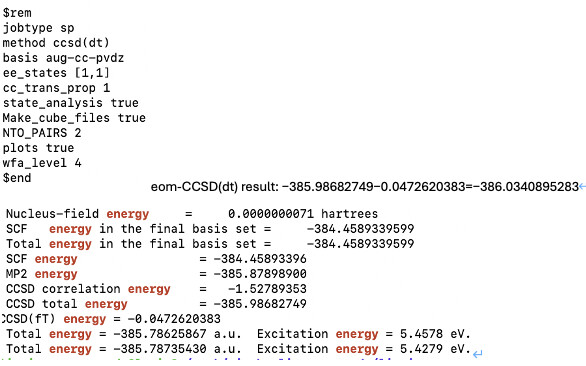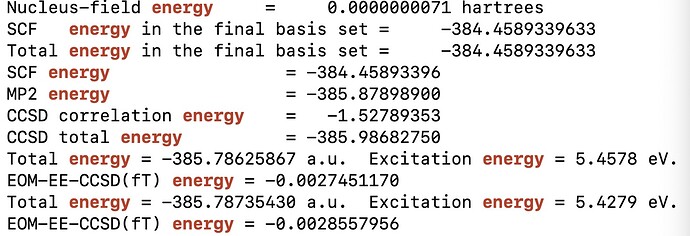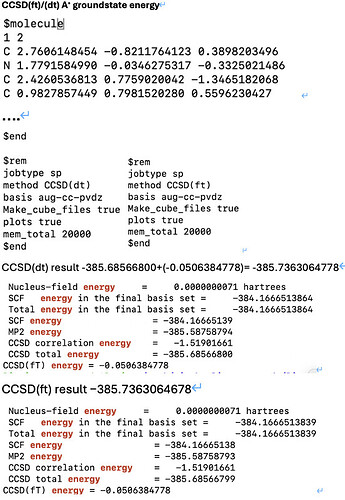I am currently conducting binding energy calculations using Q-Chem. Specifically, I have computed the ground-state energy of a TMEDA molecule with an additional proton (forming a positively charged ion) using CCSD(T). Additionally, I have computed the excited-state energies of the TMEDA molecule using both EOM-CCSD(FT) and EOM-CCSD(DT) methods. The energy difference between the excited state and the ground state serves as the FC (t0) binding energy.
I have encountered several questions regarding the interpretation of the calculation results:
-
For the ground-state calculation of the positively charged ion (charge set as 1, Multiplicity set as 2), should I extract the energy from the “CCSD(T) total energy” line or “CCSD total energy”?
-
For the excited-state calculations, I noticed that there is no difference between the results obtained using EOM-CCSD(FT) and EOM-CCSD(DT) methods. What could be the reason for this, and should I extract the energy from the “CCSD total energy” line or the subsequent “total energy” line?
I would appreciate any insights or suggestions regarding these questions. Thank you very much for your help.
For EOM-EE-CCSD(fT) excitation energies, you need the (fT) correction in the CCSD energy, which is not being triggered through your $rem input; probably, you set “METHOD” $rem variable to “EOM-CCSD(fT)”. In your $rem, set “METHOD = CCSD(fT)” along with the EE_STATES variable, instead of “METHOD = EOM-CCSD(fT)”. This will run both CCSD(fT) and EOM-EE-CCSD(fT) calculations.
(1) Once you follow the above suggestion, your output will have a printout after the CCSD Lambda calculation for the (fT) correction to the CCSD total energy (in hartrees). If you do not see this printout, please post your input file. Now, you have to add this (fT) correction to the CCSD total energy and use it as your ground state. Similarly, you add the (fT) correction in the printout
"
EOM-EE-CCSD(fT) energy = <ft correction in hartrees>
"
to the EOM-CCSD energy for the EE target state in line
"
EOMEE transition n/Irrep
Total energy = <eom-ccsd energy> a.u. Excitation energy = <eom-ccsd energy> eV.
"
Then, the difference between (fT) corrected EOM target state energy and the (fT) corrected CCSD total energy is the excitation energy that you are looking for. You can then do a similar thing for EOM-EE-CCSD(dT) excitation energies.
(2) Could you please report both your (fT) and (dT) outputs? The (fT) and (dT) corrections can have similar but not necessarily equivalent values. The formal difference between the two energy corrections resides in the respective denominators, and maybe for small systems such as yours, the corrections give very similar values. Also, the “CCSD total energy” line is the CCSD total energy. The other “Total energy” is for the EOM-CCSD target state energy. Please refer to the output file and not just the output from “grep”. Both these lines as explained in point (1) do not include the (fT) or (dT) corrections; so, they are equivalent in separate (fT) and (dT) calculations.
Hope that helps.
Thank you very much for your reply, under your advisement, I conducted the CCSD(ft)/dt calculation for the ground state of ionic A,
from the result, I found even I use ccsd(dt) in the input file, the output files are represented as the same ft corrections, something strange.
Meanwhile, we also calculated the A excited states by eom-ccsd(dt), there is the input and output results, then we found the binding energy is followed by this formula:A* (excited state) → A+ (vertical or relaxed) + e- (free), −385.7363064778−(−386.0340895283)=0.2977830505 a.u.about 8.1 eV, which is much larger than the experimental value 2.7 eV. We are seeking insights into this discrepancy and any potential factors that may contribute to it. Any suggestions or explanations would be greatly appreciated.
Thank you for your assistance.
The (dT) correction works only with “CCMAN2 = false”. Without this setting, you will see a CCSD(fT) calculation even when you set “METHOD = CCSD(dT)”. We will fix this undesirable behavior in a future Q-Chem release.


